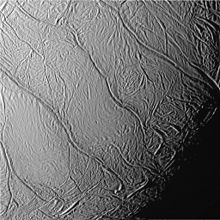
The tiger stripes of Enceladus consist of four sub-parallel, linear depressions in the south polar region of the Saturnian moon.[1][2] First observed on May 20, 2005, by the Cassini spacecraft's Imaging Science Sub-system (ISS) camera (though seen obliquely during an early flyby), the features are most notable in lower resolution images by their brightness contrast from the surrounding terrain.[3] Higher resolution observations were obtained by Cassini's various instruments during a close flyby of Enceladus on July 14, 2005. These observations revealed the tiger stripes to be low ridges with a central fracture.[2] Observations from the Composite Infrared Spectrometer (CIRS) instrument showed the tiger stripes to have elevated surface temperatures, indicative of present-day cryovolcanism on Enceladus centered on the tiger stripes.[4]
- ^ Drake, Nadia (9 December 2019). "How an Icy Moon of Saturn Got Its Stripes - Scientists have developed an explanation for one of the most striking features of Enceladus, an ocean world that has the right ingredients for life". The New York Times. Retrieved 11 December 2019.
- ^ a b Cite error: The named reference
Porco Helfenstein et al. 2006was invoked but never defined (see the help page). - ^ J. Perry (23 May 2005). "New Enceladus Raw Images". Retrieved 22 March 2006.
- ^ Spencer, J. R.; Pearl, J. C.; Segura, M.; Flasar, F. M.; Mamoutkine, A.; Romani, P.; Buratti, B. J.; Hendrix, A. R.; Spilker, L. J.; Lopes, R. M. C. (2006). "Cassini Encounters Enceladus: Background and the Discovery of a South Polar Hot Spot". Science. 311 (5766): 1401–1405. Bibcode:2006Sci...311.1401S. doi:10.1126/science.1121661. PMID 16527965. S2CID 44788825.